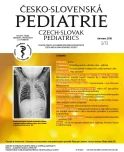Transitory hypertrophic cardiomyopathy in newborn with a neonatal withdrawal syndrome
Authors:
J. Nikolinyová 1; T. Šrámková 1; T. Baška 2
Authors‘ workplace:
Neonatologická klinika SZU, Fakultná nemocnica s poliklinikou F. D. Roosevelta, Banská Bystrica
1; Ústav verejného zdravotníctva, Jesseniova lekárska fakulta v Martine, Univerzita Komenského v Bratislave
2
Published in:
Čes-slov Pediat 2018; 73 (3): 149-154.
Category:
Case Report
Overview
The hypertrophic cardiomyopathy in newborn is very rare. It is often unknown in neonatal age and don´t have to be manifested until infantile age, when the unexpected death is set up. It is the most frequently occuring in newborns, whose mother have suffered from diabetes, in cases of metabolic systems, infectious diseases or as a result of the action of different types of toxins. Taking psychoactive addictive narcotics during pregnancy influents noticeably mother, course of pregnancy, fetus, delivery and newborn as well. Intrauterine exposure to psychoactive addictive substances may cause congenital fetal developmental defects, intrauterine growth restriction, increased risk of premature birth.
In the present case report, we describe the case of transient hypertrophic cardiomyopathy in newborn of a substance abusing mother.
Key words:
phypertrophic cardiomyopathy, neonatal abstinence syndrome, newborn
Sources
1. Alday LE, Moreyra E. Hypertrophic cardiomyopathy in infants and children. http://cdn.intechweb.org/pdfs/27266.pdf.
2. Freedom RM, et al. Neonatal Heart Disease. Springer Science & Business Media, 2012 : 695–722.
3. Pober BR. Williams-Beuren syndrome. N Engl J Med 2010; 362 : 239–252.
4. Marian AJ. Hypertrophic cardiomyopathy. In: Cardiovascular Genetics and Genomics for the Cardiologist. Dzau Liew. Malden, Massachusetts: Blackwell Futura, 2007 : 30–54.
5. Moser-Bracher A, Meinhold A, Hug MI, et al. Severe neonatal hypertrophic obstructive cardiomyopathy. http://www.neonet.ch/files/2214/0628/8754/Cotm-March-2013.pdf.
6. Kale Y, Aydemir O, Ceylan O, et al. Hypertrophic cardiomyopathy after a single dose of dexamethasone in a preterm infant. Pediatrics & Neonatology 2015; 56 (4): 268–270.
7. Magner M, Ješina P, Klement P, et al. Význam časné diagnostiky dědičných metabolických poruch s manifestací v novorozeneckém věku. Čes-slov Pediat 2013; 68 (1): 3–11.
8. Celik M, Tuzun H, Aldudak B, et al. Transient isolated right ventricular hypertrophy in a neonate, Int J Clin Cardiol 2015; 2 : 6.
9. Gomella TL, Cunningham MD, Eyal F, et al. Neonatology. 7th ed. UK: McGraw-Hill, 2013 : 715–724.
10. Füssiová M, Demová K, Lelovská R, Bauer F. Neonatálny abstinenčný syndróm – stále aktuálny problém v neonatológii. Lek Obz 2016; 12 : 341–348.
11. Kliment M. Rizikové správanie rodičov počas tehotenstva a po narodení dieťaťa. Via Pract 2007; 4 (7/8): 360–362.
12. Macmullen NJ, Dulsko LA, Blobaum P. Evidence-based interventions for neonatal abstinence syndrome. Pediatric Nurs 2014; 40 (4): 165–172.
13. Jansson LM. Neonatal abstinence syndrome, commentary. Acta Paediatrica 2008; 97 (10): 1321–1323.
14. Hudak ML, Tan R. The Committee On Drugs; The Committee On Fetus And Newborn; American Academy of Pediatrics. Neonatal drug withdrawal. Pediatrics 2012; 129 (2): e540–e560.
15. Peychl I. Neonatální abstinenční syndrom. Čes-slov Pediat 2001; (11): 663–666.
16. Binder T. Drogy, alkohol a kouření v těhotenství. In: Hájek Z, et al. Rizikové a patologické těhotenství. Praha: Grada Publishing, 2004 : 223–231.
17. Poláčková R. Abstinenční syndrom. In: Janota J, Straňák Z, et al. Neonatologie. Praha: Mladá fronta, 2013 : 16–23.
18. Minnes S, Lang A, Singer L. Prenatal tobacco, marijuana, stimulant, and opiate exposure: outcomes and practice implications. Addict Sci Clin Pract 2011; 6 : 57–70.
19. Watkins RE, Elliott EJ, Wilkins A, et al. Recommendations from a consensus development workshop on the diagnosis of fetal alcohol spectrum disorders in Australia. BMC Pediatrics 2013; 13 : 156–165.
20. Wilson J, Thorp JR. Substance Abuse in Pregnancy. Global Library of Women‘s Medicine. http://www.glowm.com/section_view/heading/Substance%20Abuse%20in%20Pregnancy/item/115.
Labels
Neonatology Paediatrics General practitioner for children and adolescentsArticle was published in
Czech-Slovak Pediatrics

2018 Issue 3
- What Effect Can Be Expected from Limosilactobacillus reuteri in Mucositis and Peri-Implantitis?
- The Importance of Limosilactobacillus reuteri in Administration to Diabetics with Gingivitis
Most read in this issue
- C3 glomerulopathy – a new clinical entity
- Current approach to asthma diagnosis and treatment in children
- News in cardiopulmonary resuscitation – „guidelines 2018“
- Macro AST – cause of asymptomatic aspartate aminotransferase elevation – case report
